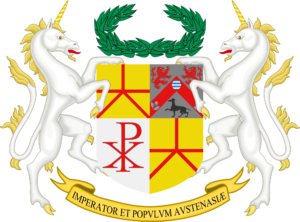By Chris Ramsay, Chief Herald
In an edict on Friday afternoon, His Imperial Majesty, Aggelos I, proclaimed a new Imperial Coat of Arms. It succeeds the almost 14 year old coat of arms that many have grown to recognise.


Considering the former’s lack of heraldic integrity and of graphic volatility and representation, it was decided that a new coat of arms was necessary. Following the abdication of Jonathan I, it became even more urgent to remove the immediate links to the Austen family, as is thought to have been the case in the second quarter of the old coat of arms. Chris Ramsay was appointed Chief Herald on 19 March to fulfil that task, and to devise a new coat of arms in conference with the Emperor, the Prime Minister, and the Crown Prince.
The new coat of arms conserves the charm and sentimentality of the old coat of arms, eradicating any instances of false quartering or lack of adherence to heraldic conventions, and taking in use for the first time a new heraldic imperial crown and a representation of the Glorious Order of Saint John. It features a chevron on a shield of the national colours, red and gold, from the arms of the House of Austen, of which Austenasia bears its name and flag. The latter of which also feature on the first and fourth quarter of the old arms. There are two lions combatant, from the second quarter of the old arms, and there is a simple Chi-Rho Christogram in the base, from the third quarter of the old arms.
On either side of the shield are the two unicorns, as they were in the old coat of arms, utilised this time to give the piece a recognisable layout and an even shape. On the top of the whole is a new Imperial Crown, inspired lightly from the eastern crown, the Orthodox Christian miter, and the flourished crowns of the late middle ages. The wreath, previously of the crest where it took on almost civic attributes a la Republican Spain, was instead moved to the bottom, where it binds the entire coat of arms together, and connects it to the new insignia of the Order of St. John.
The new Imperial coat of Arms comes in at least two different versions, with and without a mantle. It will be exciting to see the distinction of their use, the development of auxiliary heraldic devices, and of heraldic armorials and achievements of both Austenasian land and people. To that end the nobility and knighthood, falling in the latter category, can direct any heraldic inquiries or requests to the Chief Herald.